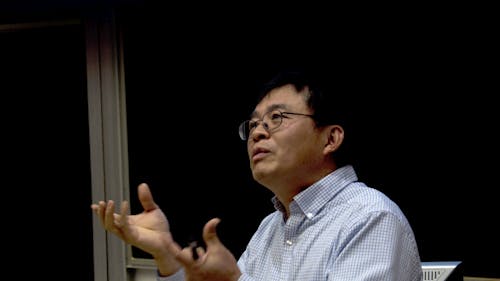Researcher discusses solar cell technology at Rutgers

As the world becomes more aware of the environmental impacts of greenhouse gasses, researchers are finding more efficient ways to harness alternative energy.
One such researcher is Xiaoyang Zhu, a professor at Columbia University in the Department of Chemistry, who focuses mainly on light-matter interaction. Zhu discussed his lab’s research on Feb. 10 in the Physics Lecture Hall on Busch campus at a colloquium hosted by the Department of Physics and Astronomy.
Light-matter interactions include light emission and solar energy conversion. Research into solar energy conversion involves exploring how solar energy is carried and how that energy can be used to increase solar cell efficiency, according to his website.
Zhu’s lecture discussed the “feverish research activities” into perovskite solar cells, a semiconductor with many unique properties that can give <g><g><g>tremendous</g></g></g> performance, according to the colloquium’s information page.
Perovskite cells come from a crystal structure with a positively charged ion in the middle. The crystal is made of molecules of one lead atom bonded to six chlorine, <g><g><g>bromine</g></g></g> and/or iodine atoms, lining up and interacting with each other, according to a research paper investigating perovskite cells.
Compared to other solar cells, perovskite cells have shown marked improvements in efficiency in under five years, going from an efficiency of 14 percent to 21 percent in just 3 years, according to a graphic by the National Renewable Energy Laboratory.
Semiconductors use different particles, called “carriers,” to carry a current. The time it takes for one type of carrier to be eliminated is called the “carrier lifetime.” A carrier with a long lifetime can carry it’s energy longer, and that may be the reason for perovskite’s high efficiency, Zhu said.
The carriers in perovskite cells may behave like <g><g>polaron</g>s</g> or particles that interact with other particles as if they are charged. Having a polaronic nature may enable the particles to carry their energy longer, have a smaller chance of being eliminated and decreased vibration of atoms, he said.
Through many different trials and experiments, Zhu showed the carrier lifetime in perovskite cells lasting up to 100 picoseconds, almost three orders of magnitude greater than the carrier lifetime in other semiconductors.
Typical carriers in a semiconductor take in energy and lose it very quickly. Perovskite, on the other hand, has carriers that lose some of the energy quickly and the rest over a longer period of time, he said.
“If you plot out this shift as a function of time, you get exactly 250 femtoseconds. That is the timescale. Whatever we excite initially is forming something else,” Zhu said. “When forming this (new) species, we are retaining this excess energy.”
Having such a long lifetime enables the cell to hold that excess energy longer, giving it time to move the energy through the semiconductor. As more of these energized carriers can exist at the same time, the cell can hold more solar energy and be considered more “efficient,” he said.
The ratio of the amount of energy the cell holds to the amount of energy supplied to the cell by the sun is referred to as the solar cell’s “efficiency,” according to the U.S. Department of Energy website.
There is a theoretical maximum efficiency that can be achieved by solar cells at a certain energy level, called the Shockley-Queisser limit, according to the research paper that established that value.
The existence of many energized carriers at once may lead to an efficiency exceeding the Shockley-Queisser limit by preventing some of the solar energy from being converted to heat, Zhu said.
“The Shockley Queisser limit for (perovskite) is about 31 percent,” he said. “If you can capture these two energies, thermalization and band gap, your efficiency goes way up.”
After doing many calculations, Zhu’s group found that the normal perovskite cell efficiency of 31 percent can go between 40 and 60 percent by retaining some of the energy that normally gets transferred to heat, he said.
While the research is very promising, it would be difficult to obtain the high energy inputs needed from the sun in everyday use, Zhu said. Perovskite solar cells may not be the answer to alternative energy today, but they appear to hold massive potential.
___
Harshel Patel is a School of Arts and Sciences sophomore majoring in molecular biology and biochemistry. He runs the Science section of The Daily Targum. He can be found on Twitter @harshel_p.



